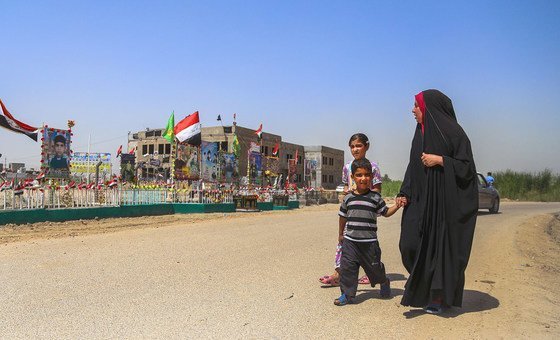Under-Secretary-General Vladimir Voronkov briefed the Security Council where he presented the latest UN report on the terrorist organization, underlining the need for concerted global action.
Mr. Voronkov began by focusing on the plight of victims and survivors of terrorism worldwide.
“Because beyond the headlines and behind the numbers, there are numerous people and communities who were affected by the heinous crimes of Da’esh and other terrorist groups and individuals,” he said.
Still a concern
The Da’esh threat remains high and has increased in and around conflict zones where the group and its affiliates are active, he reported.
Their expansion in central and southern Africa, and the Sahel, remains particularly worrying.
“Previous reports raised concerns over an increased risk of attacks in non-conflict areas by unaffiliated lone actors and small cells inspired by Da’esh as pandemic-related restrictions eased,” he told ambassadors.
“While this has not materialized over this reporting period, the level of terrorist activity continues to be a concern to Member States.”
Tech-savvy terrorists
Da’esh also continues to use the Internet, social media and video games for propaganda and recruitment purposes, along with new and emerging technologies, such as unmanned aerial systems, or drones.
Meanwhile, scores of people affiliated with the extremists, including children, remain in camps and detention facilities in northeast Syria.
Mr. Voronkov drew attention to the dire situation, warning against the far-reaching consequences and slow pace of repatriations.
Foreign fighter fears
He emphasized that the foreign terrorist fighter issue is not exclusive to Iraq and Syria, but a global challenge, with implications that go beyond accountability and prosecution for crimes.
Fighters with battlefield experience who are relocated to their homelands, or to third countries, further compound the threat.
“As noted in the report, terrorist attacks committed by such individuals have proven to be particularly lethal compared to those committed by purely homegrown terrorists,” he said.
“There are also instances of some radicalized women associated with Da’esh who reinvent themselves as recruiters, indoctrinating others, and, in particular, children.”
Rooted in rights
Mr. Voronkov outlined three recommendations to address the persistent threat posed by Da’esh and its affiliates.
He called for multidimensional approaches, with “more complementarity” between security responses and preventive measures. These strategies must be gender-sensitive and anchored in international law and human rights.
Finally, given the increased threat from conflict zones, he stressed the need to better understand the complex relationship between conflict and terrorism.
Cooperation and compliance
Another top UN official, who also briefed ambassadors, underscored the importance of greater global collaboration in defeating the terrorists.
“Only by working multilaterally and cooperatively will we succeed in mounting an effective response to the evolving global terrorist threat,” said Weixiong Chen, acting head of CTED, the secretariat for the Council’s own Counter-Terrorism Committee (CTC).
“Our measures must be tailor-made, age and gender-responsive, and human rights-compliant,” he added.
Mr. Chen also reported on recent efforts to address terrorists’ use of new and emerging technologies, such as the Delhi Declaration, adopted last October in India.
The Declaration aims to cover main concerns surrounding issues that include the abuse of drones, information and communication technologies, and new online payments and fundraising methods.
Focus on gender
Meanwhile, civil society representative Franziska Praxl-Tabuchi, underscored why gender-responsive approaches must be included in counter-terrorism programmes and policies.
This is not just a matter of realizing the participation of women, she said, but is instead about ensuring inclusive, equitable participation and leadership of people of diverse gender identities.
“It requires accounting for the experiences, needs, and challenges of individuals and recognizing how gender identities relate to other identity factors,” said Ms. Praxl-Tabuchi, who spoke on behalf of the Global Center on Cooperative Security, an independent, non-partisan policy and research institute.
“Simply put, integrating a gender perspective is a prerequisite for successful human rights–based and people-centered policies and programmes intended to address peace and security issues, including those that aim to counter violent extremism and terrorism.”

